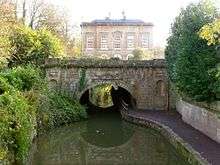Sydney Gardens Tunnels
The Sydney Gardens Tunnels are two canal tunnels on the Kennet and Avon Canal in Bath, UK.[1][2] The No. 1 Tunnel (also known as the Cleveland Tunnel) brings the canal into Sydney Gardens from the south and the No. 2 Tunnel (also known as the Sydney Gardens Tunnel) exits the gardens to the north. Both tunnels are Grade II* listed, and are two of three on the waterway—the third being the Bruce Tunnel in Wiltshire.
 The No. 1 Tunnel under Cleveland House | |
| Overview | |
|---|---|
| Location | Bath, UK |
| Coordinates | 51.3857°N 2.3479°W (No. 1) 51.3876°N 2.3480°W (No. 2) |
| Route | Kennet and Avon Canal |
| Crosses | Sydney Road (No. 1) Beckford Road (No. 2) |
| Operation | |
| Opened | c. 1800 |
| Operator | Canal and River Trust |
| Technical | |
| Length | 177 feet (54 m) (No. 1) 167 feet (51 m) (No. 2) |
History
Sydney Gardens in Bathwick were laid out in the early 1790s. The Kennet and Avon Canal was cut in the years immediately following this; the canal's route took it through the gardens. The canal company and proprietors of the gardens entered into an agreement which allowed the canal to take this route provided that the canal company provide tunneling and appropriate ornamental bridges at its expense.[3] The tunnels were designed by John Rennie and constructed in approximately 1800, predating the canal's 502-yard (459 m) Bruce Tunnel by a decade.[4][5]
No. 1 Tunnel
The No. 1 Tunnel,[6] also known as the Cleveland Tunnel or the Cleveland House Tunnel,[7] is approximately 177 feet (54 m) long.[3] Like similar places in Bathwick, the tunnel and building take their name from William Vane, 1st Duke of Cleveland, who laid claim to the estate of Laura Pulteney, 1st Countess of Bath after her intestate death in 1808.[8]
The northern portal, that which is in Sydney Gardens, is more ornate than the southern and features a representation of Hafren, a water nymph associated with (and eponym of) the River Severn.[3] The Grade II* listed tunnel carries the canal beneath Sydney Road and Cleveland House, the former canal company headquarters.[3]
Cleveland House
Cleveland House was built in the late 1810s, almost twenty years after the canal and tunnel were constructed. It was designed by John Pinch and occupied by the Kennet and Avon Canal Company from its building until 1864.[9] During their tenure, it was known as Canal House. A small hatch in the basement of the building opened into the tunnel; a common (but false) explanation for this is that it was to pass paperwork between vessels and the company offices;[10][11] it is more likely that the hatch was a refuse chute.[12]
No. 2 Tunnel
The No. 2 tunnel,[6] sometimes known as the Sydney Gardens Tunnel,[7] is approximately 167 feet (51 m) in length and runs beneath the Beckford Road, John Loudon McAdam's turnpike road.[13] As with the No. 1 tunnel, the portal facing the gardens (the south portal) is the more ornate, decorated in the Adam style,[13] and features a depiction of Father Thames.[14]
References
- Ludgate, Martin (1 March 2017). "Keeping Up Appearances". Canal Boat magazine. Archant Media. Retrieved 12 March 2020.
- Garth Pedler (4 July 2017). Rail Operations Viewed From South Devon. Troubador Publishing Ltd. p. 228. ISBN 978-1-78462-258-9.
- Historic England, "Kennet and Avon Canal Tunnel (under Cleveland House and Sydney Road) (1395966)", National Heritage List for England, retrieved 13 February 2020
- Historic England, "Bruce Tunnel, West Portal (1035927)", National Heritage List for England, retrieved 13 February 2020
- Historic England, "Bruce Tunnel, East Portal (1194523)", National Heritage List for England, retrieved 13 February 2020
- "Bath No.1 Tunnel and Bath No.2 Tunnel | Canal & River Trust". canalrivertrust.org.uk. Canal and River Trust. Retrieved 12 March 2020.
- Steve Davison (30 June 2016). The Kennet and Avon Canal: The full canal walk and 20 day walks. Cicerone Press. p. 100. ISBN 978-1-78362-357-0.
- Bathwick Local History Society (6 June 2008). Bathwick: echoes of the past. Millstream Books. p. 28. ISBN 978-0-948975-84-4.
- "Cleveland House, UK | arc". arc-magazine.com. ARC Magazine. Retrieved 13 February 2020.
- C. A. Buchanan; Robert Angus Buchanan (1 January 1980). The Batsford Guide to the Industrial Archaeology of Central Southern England: Avon County, Gloucestershire, Somerset, Wiltshire. B.T. Batsford. p. 27. ISBN 978-0-7134-1364-9.
- Pearson, Michael (2003). Kennet & Avon Middle Thames:Pearson's Canal Companion. Rugby: Central Waterways Supplies. ISBN 0-907864-97-X.
- Historic England, "Cleveland House (1395310)", National Heritage List for England, retrieved 13 February 2020
- Stuart Fisher (12 January 2017). The Canals of Britain: The Comprehensive Guide. Bloomsbury Publishing. p. 122. ISBN 978-1-4729-4002-5.
- Historic England, "Kennet and Avon Canal Tunnel (Under Beckford Road) (1395965)", National Heritage List for England, retrieved 11 February 2020